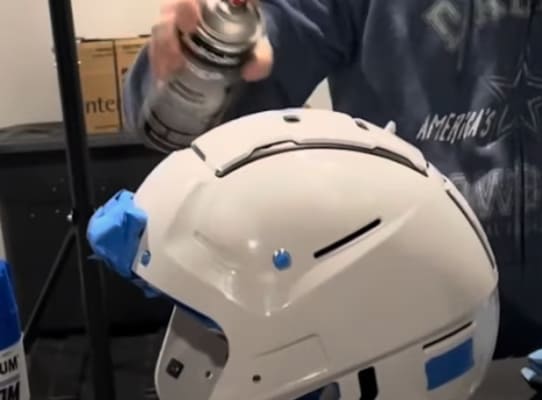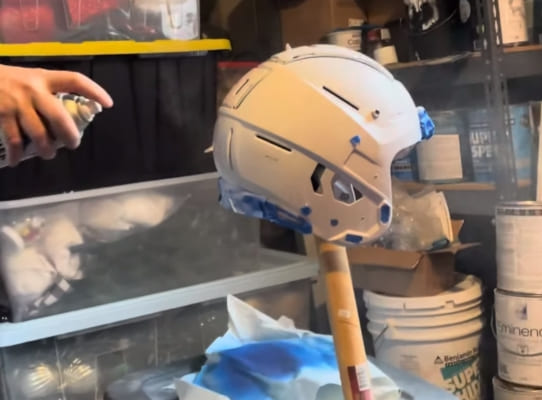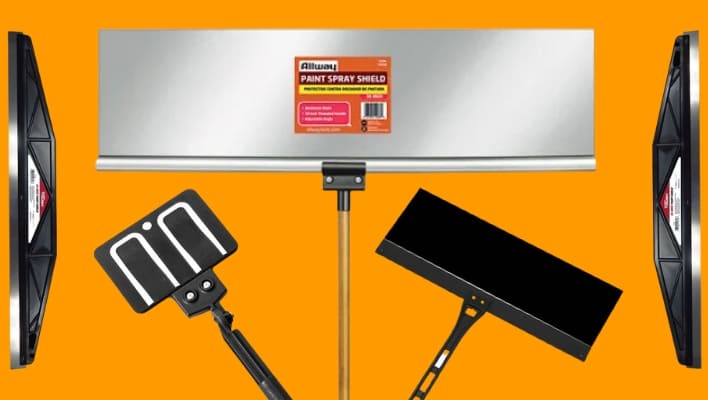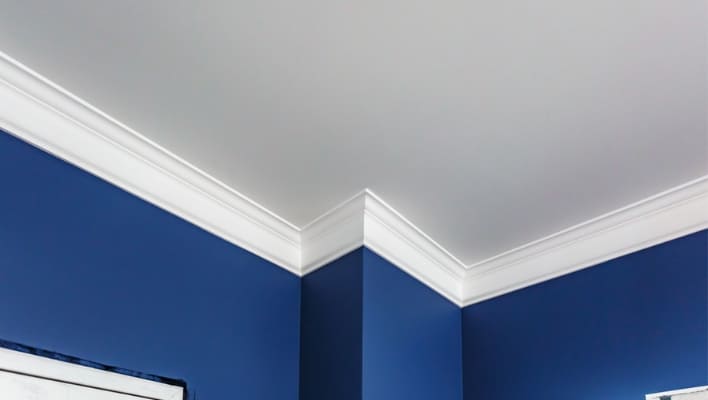The football players take to the field with an undeniable swagger, their helmets gleaming under the stadium lights. These helmets not only protect them from hard-hitting tackles but also serve as a canvas for expressing team pride and individual style.
If you’re a football enthusiast looking to customize your helmet for decorative purposes, you can paint it yourself. However, if you use it to wear on the field, i.e. for more practical use, it is recommended to find a licensed helmet reconditioner. You can find your nearby equipment reconditioning business at NAERA.
In this blog, I’ll walk you through the step-by-step process of how to spray paint a football helmet for decorative purposes, ensuring it not only looks fantastic but also maintains its durability and safety features. So, let’s begin.

Table of Contents
- How To Spray Paint A Football Helmet?
- What Kind Of Paint Do You Use On A Football Helmet?
- Automotive Paint
- How To Spray Paint A Football Helmet?
- Step 1: Gathering Supplies
- Step 2: Setting Up Your Workspace
- Step 3: Cleaning and Preparing the Helmet Surface
- Step 4: Surface Preparation
- Step 5: Interior Protection
- Step 6: Positioning the Helmet
- Step 7: Applying Primer for a Base Coat
- Step 8: Paint Application
- Step 9: Helmet Finishing and Polishing
- Step 10: Adding Stickers or Decals for Personalization
- How to Remove Paint from a Football Helmet?
- Goof Off
- Brake Cleaner
- Paint Remover
- Lacquer Stripper
- How Much Does It Cost To Get A Football Helmet Repainted?
- Can a Body Shop Tackle a Football Helmet Paint Job?
- Wrapping Up On How To paint football helmet
- Rosalie Sanchez
How To Spray Paint A Football Helmet?
There are other methods to spray paint football helmet, however, spray painting is one of the most ideal way to achieve professional-looking results. To start the process, you need to first know what type of paint is used on football helmets.
What Kind Of Paint Do You Use On A Football Helmet?
When it is about spray painting a football helmet, you should choose paint wisely. Here’s a brief overview of the key options:
Acrylic Paint
In my personal experience, I found acrylic paint to be the most eco-friendly and quick drying option for painting a football helmet. It is water-based, non-toxic, and offers a wide range of colors, making it an easy choice for customization. However, it’s less durable and may develop cracks over time.
Automotive Paint
Automotive paint, originally intended for vehicles, stands as the ultimate choice in durability when it comes to adorning football helmets. Renowned for its high-gloss finish and exceptional resistance to chipping, fading, and scratches, this paint ensures your helmet design remains pristine throughout the rigors of the game. Nevertheless, it’s worth noting that its superior quality comes at a higher cost and may pose challenges for those new to the art of helmet painting.
Enamel Paint Football Helmet
Enamel paint is the choice for durability and protection, ideal for outdoor use. It forms a strong shield against various elements but takes longer to dry and can be challenging to apply.
Polyurethane Paint
For unparalleled durability, polyurethane paint is the top pick. It resists sunlight and moisture damage exceptionally well, although it’s more difficult to apply and comes at a higher cost.
Lacquer Paint
Lacquer paint offers a balance between ease of application and protection. It dries quickly and provides long-term defense against elements but can be challenging to repair if damaged. It’s a suitable middle ground for helmet painting.
Lacquer, enamel, and polyurethane paints provide more durability, but I preferred the fast-drying and eco-friendly nature of acrylic paint for my needs.
How To Spray Paint A Football Helmet?
Painting a football helmet at home isn’t that difficult with the right approach. Here are the steps to spray paint a football helmet:
Step 1: Gathering Supplies
- Scraper
- Protective gear (safety glasses, gloves, mask)
- Spray paint booth or a well-ventilated area
- Newspapers or a drop cloth
- Sandpaper (fine-grit)
- Tack rag (lint-free cloth)
- Masking tape or painter’s tape
- Helmet hanger
- Acrylic paint (or your chosen type of paint)
- Primer specific for the helmet material
- Stickers or decals for personalization
Step 2: Setting Up Your Workspace
Put on your safety gear to get yourself protected from harmful paint fumes and debris.
Select an area with good ventilation for spray painting, particularly outdoors. Insufficient ventilation in the rooms where you’re painting can lead to a buildup of toxic paint fumes, resulting in breathing difficulties and pose potential health and safety risks, including symptoms such as dizziness and nausea.
If you’re indoors, use a spray paint booth or create a DIY paint booth by hanging plastic sheets to contain overspray. Make sure the floor is protected from paint by laying newspapers or a drop cloth.
Step 3: Cleaning and Preparing the Helmet Surface

Remove any stickers, decals, or face mask components from the helmet. Use a scraper to delicately remove any persistent decals or sticky residue.
To remove tough stains, I would recommend a quality greaser cleaner like Khaki Tom Visor Helment cleaner because it’s one of my top choices for tough stains and adhesive residue removal on my football helmet.
Wear gloves when touching the helmet to avoid leaving fingerprints. Make sure the helmet looks completely clean without any scratches.
Step 4: Surface Preparation
Sand the entire surface of the helmet with Random Orbital Sander. This will create a slightly rough surface, allowing the paint to adhere better. After sanding, wipe the helmet clean with a tack rag to remove dust and debris.
Step 5: Interior Protection
If your helmet has removable padding or components, remove them to prevent paint from getting inside. Cover the interior with newspapers, plastic bags or tape to protect it from overspray.
Step 6: Positioning the Helmet
For achieving a consistent and efficient coat on the entire helmet, hang it on a helmet hanger or place it on a stable platform, ensuring it’s elevated and easy to access from all angles.
If that’s not available, using a bent wire hanger hung from a tree can serve as a viable and effective alternative.
Step 7: Applying Primer for a Base Coat

Primer serves to enhance paint adhesion and brings out any imperfections on the metal and wood surfaces.
Apply a Krylon K05584007 primer specifically designed for the material of your helmet. The reason I opt for this primer is that it’s designed to create a perfect foundation for the paint, ensuring great adhesion and a flawless finish.
Review the manufacturer’s provided instructions thoroughly before proceeding with the primer application. To achieve a top-notch paint job on your helmet, apply multiple coats of primer to the shell. After the application of the primer, allow it to dry for around 2 to 3 hours.
Note: Visit our article to learn about the age limitations when it comes to buying spray paint!
Step 8: Paint Application

For painting helmet, I have tried different paints, among which I found the following ones as the best spray paint for football helmets:
Rust-Oleum 249127 2X Ultra Cover Paint
Rust-Oleum 2X ultra cover paint is a matte finish marvel. Its versatility can cover the helmet’s various materials flawlessly, and the low odor oil-based formula ensures a chip-resistant, long-lasting texture.
The rapid drying time of 20 minutes, excellent coverage, and the convenience of any-angle spray make the process smooth, while the popular color options added a touch of personal style to your helmet.
Krylon K04112000 Waterfall Paint
This paint effortlessly produces an ultra-matte finish, offering exceptional adhesion and durability on metal surfaces. What’s more, there’s no need for primer or extensive prep work when applying Krylon K04112000 paint.
It dries quickly within 10 to 15 minutes, making the painting process a breeze, and the semi-gloss adds an appealing touch to your project.
SEYMOUR 620-1415 High Solids Paint
Another great choice, SEYMOUR 620-1415 offers exceptional coverage, roughly 3-4 times more than standard aerosol paints, with no running or sagging. This paint not only protects against rust, weather, and corrosive chemicals but also withstands abrasion and heat.
The SEYMOUR paint in gloss black delivers an impressive coating with a sleek, shiny appearance. Its quick drying time of just 30 minutes and single-coat hiding make it a highly efficient option.
How To Apply Paint?
Shake the spray paint vigorously for a full minute to ensure thorough mixing for an even coat. Hold the can away from the helmet for about 8-12 inches and begin applying smooth coats in a flow. Start with a thin layer to prevent drips or runs.
Leave the first coat in place to dry completely before applying additional coat layers. Apply 2-3 coats, ensuring each coat dries completely in between applications to achieve a flawless and seamless paint job.
Step 9: Helmet Finishing and Polishing

After the final coat of paint has dried completely, you can choose to apply a clear protective DecoArt DS17-9 Dads17-9 Acrylic Sealer to seal the paint and enhance durability.
Step 10: Adding Stickers or Decals for Personalization
Once the paint and clear coat are dry, personalize your helmet further by applying stickers or decals. Place them strategically on the helmet to express your team pride or individual style.
How to Remove Paint from a Football Helmet?
Removing paint from a football helmet could be very challenging; sanding is a time-consuming option. I am sharing alternative methods for easier paint removal from helmet.
Goof Off
Goof Off is a reliable method for paint removal from a football helmet. Apply Goof Off paint remover to a clean cloth or sponge, gently rub the painted area, and follow product instructions. Repeat as needed and clean the helmet with a common soap and water to get rid of any residue.
Brake Cleaner
Using brake cleaner is an effective way to eliminate paint from a football helmet. Begin by applying brake cleaner to a clean cloth or sponge and gently rubbing the painted area. Use a gentle brush or soft cloth for any necessary scrubbing. Rinse off the helmet with water and mild soap to eliminate any buildup.
Paint Remover
Commercial paint remover is another viable method for stripping paint from a football helmet. Start by applying the paint remover to the painted area, while removing the softened paint using a plastic scraper or brush. Once removed completely, clean the helmet thoroughly.
Lacquer Stripper
Lacquer stripper is a potent option for paint removal on a football helmet. Apply the lacquer stripper to the painted area, followed by the same procedure as the above paint removal methods.
How Much Does It Cost To Get A Football Helmet Repainted?
The cost of repainting a football helmet can range from $40 to $100 or more per helmet, relying on certain aspects such as the helmet’s condition and wear since its last refurbishment.
On the other hand, if you decide to undertake the project yourself, your expenses will be limited to purchasing spray paints and basic tools like a screwdriver for face mask removal and sandpaper.
While the DIY paint football helmet option is more budget-friendly, you have to practice to get professional-quality paint job results.
Can a Body Shop Tackle a Football Helmet Paint Job?
Using techniques similar to those used for painting automotive parts and motorcycles. a body shop is equipped to tackle a football helmet paint job. To ensure your specific preferences are met, communicate your requirements clearly with the shop.
Wrapping Up On How To paint football helmet
Mastering the techniques to spray paint a football helmet offers a creative way to customize your automotive gear. From selecting the right type of paint to following our step-by-step process, painting your football helmet is now possible with the right products.

Rosalie Sanchez
DIY enthusiast with years of experience in home decor and home improvement. With a passion for educating consumers about DIY projects. Every time, I work with our painting professionals to provide you with the best painting product reviews and how-to advice. You can follow me on Facebook.


